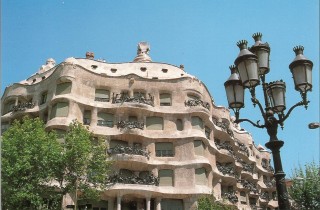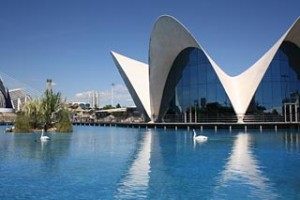The Catalan Language
4 million speakers out of the Spanish population of 45 million may not initially sound huge, but in those communities who do speak it, Catalan has a significant standing. A somewhat maligned language, it has a turbulent history which highlights the point of contention it long has been. Fundamentally though, despite the presence of other minority languages in Spain such as Basque and Galician, Catalan is the most prominent.  Catalan is, to most of its speakers a very important sign of identity, something precious, unique and to be proud of. The reasons are many, such as the ancestral Catalan culture involving all the arts and inherited traditions passed down through generations, but one of the most remarkable is the fact that for a long long time Catalan was forbidden in public and this was a source of sadness and a sense of repression.
Catalan is, to most of its speakers a very important sign of identity, something precious, unique and to be proud of. The reasons are many, such as the ancestral Catalan culture involving all the arts and inherited traditions passed down through generations, but one of the most remarkable is the fact that for a long long time Catalan was forbidden in public and this was a source of sadness and a sense of repression.
The language is spoken primarily in Catalonia, Valencia, the Balearic Islands and La Franja (the eastern side of Aragon), as well as in a few parts of Murcia. In the first three of these, it is, along with Spanish, the official language.  It is also the only official language in the country Andorra, and spoken in parts of Southern France (the old Roussillon, corresponding to areas of Pyrénées-Orientales). It even extends to Alghero in Sardinia.
It is also the only official language in the country Andorra, and spoken in parts of Southern France (the old Roussillon, corresponding to areas of Pyrénées-Orientales). It even extends to Alghero in Sardinia.
Catalan developed out of the Vulgar Latin which was spoken in Hispania Tarraconensis, the Roman province basically covering modern north-eastern Spain. It was distinct from Latin by the late 10th century and thought to have featured in written documents for the first time in the 12th century, the earliest known examples being six sermons and a religious charter. Having previously written in Provençal, Catalan poets began to use this language for their work from the 13th century onwards.
The conquest of the kingdoms of Valencia and Murcia by James I of Aragon during the 13th and 14th centuries induced the expansion of the language across a greater area, including El Carche (el Carxe in Catalan) in Murcia, where it is still spoken. You will see many Valencian and Catalan institutions named after this great king and his heir Jaume II el Just. The union of the Aragonese and Castillian crowns in 1474 eventually led to a decline in Catalan's status. In the meantime though, Valencia experienced its 'Golden Age' in the 15th century, a time when it was one of the largest and most culturally important cities in Europe. This can be considered the zenith of the Catalan language's status.
 Royal decrees by Louis XIV of France in the 17th century and Philip V of Spain in the early 18th, largely eliminated the use of Catalan in documents and public administration. In commemoration of these actions, there is a painting of Philip V which hangs upside down in the city of Xativa, and every year Valencian people celebrate a festival with concerts and meetings vindicating their rights to speak Catalan and their joy of belonging to a thriving speaking community. It is hard to understand how strong the Valencian and Catalan people feel about their language, but it is natural than when something is forbidden, one becomes more and more fond of it, in this case appreciating enormously the normality of being able to speak your native language with no fears.
Royal decrees by Louis XIV of France in the 17th century and Philip V of Spain in the early 18th, largely eliminated the use of Catalan in documents and public administration. In commemoration of these actions, there is a painting of Philip V which hangs upside down in the city of Xativa, and every year Valencian people celebrate a festival with concerts and meetings vindicating their rights to speak Catalan and their joy of belonging to a thriving speaking community. It is hard to understand how strong the Valencian and Catalan people feel about their language, but it is natural than when something is forbidden, one becomes more and more fond of it, in this case appreciating enormously the normality of being able to speak your native language with no fears.
Yet there came a Catalan renaissance. In the 19th century, the Renaixença pushed the language back to the forefront of cultural movements, helped by the emerging upper-class who promoted the cultural awareness of Catalonian traditions and Catalan as source of artistic creativity and as a self-assertion that would unite towns and differentiate them from the rest of the Spanish state.
While Catalan had been marginalised, sidelined from administrative functions in the Decretos de Nueva Planta, the Renaixença movement aimed to reinvigorate the language by means of the exposure that it would get by flourishing in artistic contexts. The poetry contests of the Jocs Florals (Floral Games) were re-established in Barcelona using Catalan, once again helping to promote the language by means of verse. The push didn't stop there though.
 Moving into the 20th century, in 1906, a Catalan Language Congress was held, and a year later, the Institut d'Estudis Catalans (Institute of Catalan Studies) was founded. This institute published Normes ortogràfiques (spelling rules) in 1913 and a Diccionari ortogràfic (spelling dictionary) in 1917. The grammarian Pompeu Fabra produced a book of Gramàtica catalana one year later.
Moving into the 20th century, in 1906, a Catalan Language Congress was held, and a year later, the Institut d'Estudis Catalans (Institute of Catalan Studies) was founded. This institute published Normes ortogràfiques (spelling rules) in 1913 and a Diccionari ortogràfic (spelling dictionary) in 1917. The grammarian Pompeu Fabra produced a book of Gramàtica catalana one year later.
Under the dictatorship of Miguel Primo de Rivera, the language was again banned. It was subsequently restored as an official language during the Second Republic (1931-1939). The Generalitat de Catalunya was revived. But whenever the language has achieved a degree of prominence, some official intervention has quickly taken that away again. The next to do so was the dictatorship of General Francisco Franco.
Franco strongly discouraged public speaking of Catalan by means of official propaganda campaigns. It was also banned in the media, government-run institutions and public events. However, by the 1950s, it was permitted in the theatre. The use of Catalan in advertising, schools and on road and shop signs was banned. Things became less extreme as times went by, but during 40 years under Franco’s rule, Catalan was never officially recognised.
As restrictions on languages other than Spanish grew less draconian through the Franco era, there were elements at work that were creating a foundation for the future- a course in Catalan philology began to be offered from 1944, and a chair of Catalan language and literature was created in 1961.
After Franco's death in 1975, the nation went through widespread change with the return of the monarchy and democratic government. One of the earliest measures that provided a platform for state recognition of Catalan was the nation's all-important 1978 Constitution, Article 3 of which stated that 'Castillian is the official language of the State' and that 'the other Spanish languages will also be official in their respective Autonomous Communities according to their own Statutes'.  Becoming an autonomous community helped the language to prosper in all sorts of official walks of life; throughout Catalonia, it became the main language in education and politics. The 1983 Law of Linguistic Normalisation (Llei de Normalització Lingüística) had a big effect on this.
Becoming an autonomous community helped the language to prosper in all sorts of official walks of life; throughout Catalonia, it became the main language in education and politics. The 1983 Law of Linguistic Normalisation (Llei de Normalització Lingüística) had a big effect on this.
Considered hugely significant in breaching the public relations gap between Catalans and the solely Castilian-speaking Spaniards was King Juan Carlos. In February 1976, a few months after Franco's death, the king made his first official visit to Barcelona. There the king astonished the assembled crowd by addressing them in Catalan. At the end, he uttered the words 'Visca Catalunya, Visca Espanya' (Long Live Catalonia, Long Live Spain).
 In Valencia, some people consider valenciana a different language, despite the assertions of the Acadèmia Valenciana de la Llengua and Institut d'Estudis Catalans to the contrary. In reality, the variation between the version spoken in Valencia and that of Catalonia is of negligible difference, although the accents are somewhat different.
In Valencia, some people consider valenciana a different language, despite the assertions of the Acadèmia Valenciana de la Llengua and Institut d'Estudis Catalans to the contrary. In reality, the variation between the version spoken in Valencia and that of Catalonia is of negligible difference, although the accents are somewhat different.
So Catalan lives on, its strength bolstered by its use in modern media such as radio and television, although in reality the language always had a sufficient base in the everyday lives of people who continued to speak it regardless of whatever legal measures were in force at the time. Life and culture in Spain are all the richer for it.
This article was kindly contributed by Learn Languages Bristol. Thank you, Mark.
Follow these links for hotels in the Catalan-speaking regions:
Catalonia
Valencia
The Balearics
And how does all this work out in practice for visitors to the area? Well most words look like their Spanish equivalents with some small spelling variations; and if not Spanish, they probably look similar to French.
Most of these variations are quite consistent, like the tendency to drop 'n' off the end of Spanish words. 'Catalan' itself in Catalan is 'Catalá'. And all the words that end in '-ción' in Spanish end in '-ció' in Catalan. Many other words replace a Spanish 'd' with a Catalan 't': for instance 'ciudad' (city) in Spanish becomes 'ciutat' in Catalan.
Easy, isn't it?
8 Feb 2016, 11:41